
Hi Archinect!
Guest blog this week from some of my friends in the MDESS, MLA, and upper-year MArch programs, who are embarking on the injection of the GSD into the arts-science-technology-design-branding fest that is the Lab at Harvard. Their exhibition is opening at 8:30 pm on October 7, 2010, at 52 Oxford Street on the Harvard campus--and you'd better be on time if you want to inhale the clouds of food!
Here it is (text and images from Etien Santiago, Day Jimenez, Mariela Alvarez, Zenovia Toloudi, Andrew Zientek, and Stephen Schaum):
We started Project on Spatial Sciences as a way for GSD students to get involved with the Lab at Harvard, which is directed by David Edwards. http://thelaboratory.harvard.edu/ Like its cousin in Paris, http://www.lelaboratoire.org/ the Lab is meant to be a breeding ground for strange inventions that defy the usual dichotomy of "art" and "science." We saw this as an opportunity to engage the experience and knowledge of people in other Harvard departments, and to explore the ways in which their research matters to architecture. It was also interesting that our group brought together not just MArch but also MDesS, PhD, and Landscape Architecture students from the GSD - countering the programmatic separations that its social habits often reify.
As we brainstormed, we realized that we could offer a unique insight to the Lab as well as to our own design professions. The study of "space" indeed underpins all of our individual work, but moreover space permeates the work of every single discipline. Why? Because space, like time, is something that humans cannot ever get away or out of. It characterizes our basic condition of existence. Everything exists in space, and nothing can exist in some abstract, space-less, relation-less vacuum. 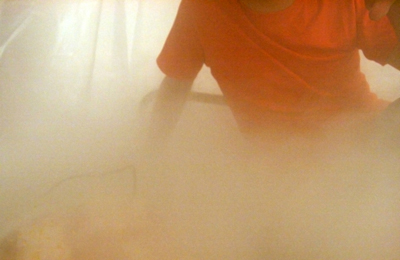
Indeed, we quickly discovered that many researchers at Harvard are currently thinking about some properties of space and the role it plays in their field of work. Certain psychologists have realized that humans do not in fact live in a white, space-less world, but that space is integral to humans' learning and communication. We found musicians who study the essential spatial component of music, biologists who theorize how different animals occupy and move through space, artists who work with fields instead of objects, mathematicians who think about non-Euclidean space, philosophers who ponder contemporary changes in our notion of space, biomedical engineers who study the body's responses to its environment, and many more. We also got in touch with people outside the academic realm whose job is to manipulate space and its many properties for commercial and infrastructural uses.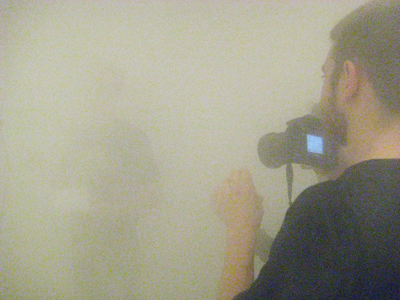
For us, architecture is not some pristine, built object that can conceptually be frozen and plucked out of the world. Instead, it exists in our messy, spatial, temporal reality - tangled up with every human's distracted apprehension of it. If we were to think about architecture as space (but not the abstract, white, Cartesian, and empty space that we usually think of), then we would open a whole new realm of possibilities. Space is very complex: it is made up of distances, of air (and its inherent sounds, particles, smells, and temperatures), of speeds, of electromagnetic radiation, of communication, of memories, of social customs, of economics... Space separates things from one another but it also joins them together; it is simultaneously our environment and information about other environments. So space is not a Euclidean grid that stays fixed while objects and people move within it; instead, it constitutes the essential relationships between all bodies.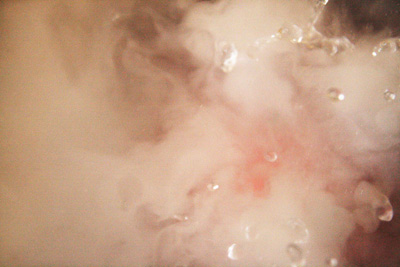
In the words of Sanford Kwinter, "Space is not a passive, unchanging physical object inside of which interesting things happen but is actually the interesting thing itself: a living tissue constantly changing and adapting to events."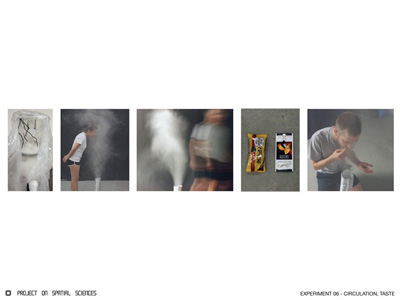
Our first installation for the Project on Spatial Sciences is an experiment where we make space breathable and tasteable. It is one of two installations that kick-off the 2010-2011 year for the Lab at Harvard. Working with a technology that the Lab originally developed for Le Whaf (a machine that transforms liquid foods into clouds, http://www.egodesign.ca/en/article.php?article_id=605 ) we created four chambers filled with different "flavor-clouds." Each chamber generates a particular environment with its gradations and temporal qualities. Visitors will be handed a tray with solid and liquid food samples which they can consume as they please, in a kind of choreography, while traversing the four taste environments.
Our aim is to provoke visitors to expand their definition of space. What if you could taste space? Since everyone is familiar with taste, this would give non-architects a meaningful and impactful way to engage conversations about space. And what if architects used smells and tastes instead of bricks and mortar? Better yet, what if architects studied and worked with space's infinitely variable properties in order to create unprecedented kinds of designs?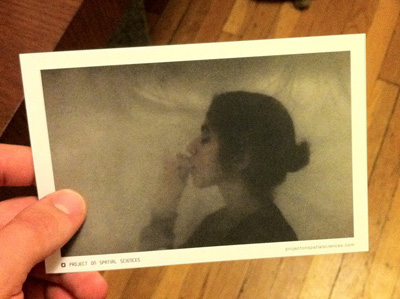
The exhibit will open at 8:30 pm on October 7, 2010, on the ground floor of the Northwest Sciences Building (on Harvard Campus), 52 Oxford St., Cambridge MA. (Be sure to arrive around that time in order to not miss out on the food-sample handouts.)
www.projectonspatialsciences.com
www.facebook.com/projectonspatialsciences
This blog was most active from 2009-2013. Writing about my experiences and life at Harvard GSD started out as a way for me to process my experiences as an M.Arch.I student, and evolved into a record of the intellectual and cultural life of the Cambridge architecture (and to a lesser extent, design/technology) community, through live-blogs. These days, I work as a data storyteller (and blogger at Littldata.com) in San Francisco, and still post here once in a while.



3 Comments
I'm intrigued, but......
aren't you just smelling the food? Your not really smelling space. Your in space, the smell is filling the space, but space isn't something that you can smell.
I think?
You can smell the materials that make space, like the smell of walking into a construction site or a gas station (which i love) but can you smell or hear space? i think its more like you can smell and hear our interactions with other objects or particles within space.
I'm not sure.
Very evocative project though!
If you start by thinking about this scientifically, you should be able to think through answers to your questions.
You can smell substances which exist in a space. When surrounded by this substance, one could perceive space solely based on smell, and therefore smell there way through space.
Similarly, one could do the same with taste. If flavor clouds did in fact exist, as this project proposes, one could lick or chomp there way around space.
I'm sure that it sounds like fun, or smells and tastes like fun!
Block this user
Are you sure you want to block this user and hide all related comments throughout the site?
Archinect
This is your first comment on Archinect. Your comment will be visible once approved.